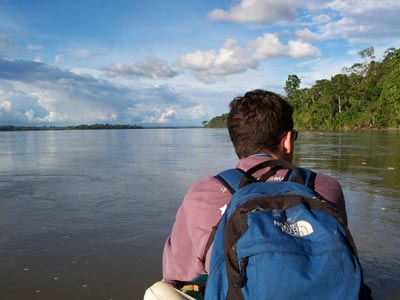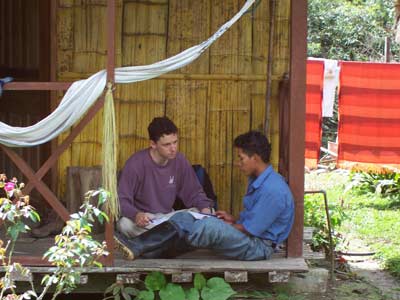Jungle Adventures in Ecuador
At first, I thought Miltón carried his rusty machete just to impress the gringos, a prop to demonstrate the wilderness of our surroundings. I was skeptical, as my jungle experience thus far had been surprisingly posh. As I was soon to discover, however, the rainforest was still plenty wild, and I’d have reason to wish for my own machete more than once during my stay.

Ecuador’s relatively small territory in the Amazon jungle offers a staggering array of options for the outdoor enthusiast. While its rainforest is still less frequently visited than those of neighboring Brazil or Peru, Ecuador has been swept up in the rising global enthusiasm for ecotourism. The dozens of “jungle adventures” that have sprung up in response provide a wide range of prices and amenities, from hardcore backpacking trips and lodges a full day’s river journey from the nearest town, to hostel-like cottages just on the outskirts of town.
I settled on Yarina Lodge, located on the western side of the Ecuadorian Amazon, which offered a reassuring blend of wilderness, accessibility, and comfort at a reasonable price. To get there, the seven travelers in my group followed a short flight from Quito to Coca, on the outskirts of the jungle, with a drive in an ancient pick-up truck to the banks of the Rio Napo. There, we picked out knee-high rubber boots and clambered into a motorized canoe for another hour of travel along the wide, coffee-colored river, arriving at last at a rickety wooden dock deep in the jungle.
Disembarking from the canoe, my husband and I lugged our bags to our private cottage, constructed of traditional, fast-growing local woods. We unpacked, admired the blooming roses and birds-of-paradise growing outside our window, and tested out the hammock strung on our porch before meeting our fellow adventurers in the open-air lodge. Taking deep breaths of the heavy, oxygen-rich air, we chatted with fellow adventurers from Belgium, Switzerland, and Quito as we sat overlooking a tributary of the river and a solid wall of trees, vines, and bromeliads.

Lunch was a seven-part smorgasbord of traditional Ecuadorian foods, ranging from freshly caught river fish to locally grown maize to cinnamon-flavored fruits plucked from nearby trees. A family of tiny tamarind monkeys leapt from branch to branch nearby, and the trees were filled with the chirps and rustlings of countless birds. I reclined in a bamboo chair and trained my binoculars on a bright aqua butterfly fluttering past, letting the calm wash over me.
This unexpectedly luxurious atmosphere melted away any thoughts I’d had about a rough jungle experience, leaving me unprepared for my introduction to Miltón, our guide, and his ever-present machete. Once our group stepped off the manicured lawns and into the jungle proper that afternoon, I sharply readjusted my perspective. Despite the comforts provided by the lodge, this place was definitely wild. With no landmarks and no clear view of the sun through the dense tree canopy, navigation was all but impossible. Wander even a few yards away from the group, and you could easily disappear into the jungle.
A thousand insects hummed in the canopy overhead as we set off down a path only Miltón could see. The air was thick with moisture, and vines seemed to stretch towards the rich earth even as I watched. Miltón put the machete to good use, hacking away creepers that had grown up in the last few days, pointing out inch-long stinging Conga ants to avoid grabbing, and quietly dispatching a small poisonous snake that coiled on the trail, nearly invisible.

Miltón paused periodically, shaking sweet, chalky berries from a tree; splitting vines to weave a basket as he walked; and chipping flakes of bark off medicinal trees. One vine tasted like mint and worked like novocaine, and we were told that local people used the sap of another as a curative for everything from cuts to bronchitis to stomach cancer. Miltón showed scars and told stories of ulcers and wounds healed by Sangre de Drago (‘Blood of the Dragon,’ so named for the ruby-red sap that oozes from cuts in the bark)—I later learned the tree was subject to several medical patents by pharmaceutical companies.
Each day we took a different path in the jungle, and each was filled with all the adventure I could want. Hearing a rustling in the underbrush along one well-traveled trail, Miltón whistled a few low notes. A few moments later our party was joined by a baby tapir, weighing perhaps two hundred pounds, which approached to have his back scratched and to eat leaves from our hands.
A snail the size of a softball crawled slowly up a tree nearby, specimens from some of Ecuador’s 1,500 bird species called overhead, and red orchids glowed amidst the darkness of the trees. With a mischievous grin, Miltón sure-footedly hopped over fallen trunks across a swamp so deep that when I inevitably fell in, only a frantic grab at a hanging vine kept me from sinking to my shoulders. The mud, miraculously, washed out of my clothes in the torrential rainstorm later that afternoon.

We learned to fish for piranha in the tributaries of the Rio Napo using only a string and a hook baited with raw meat, dangled in the same pool that visitors sometimes swam in. Miltón brought out a blowgun, used by locals to hunt monkeys and birds, and I tried my hand at wielding the heavy, six-foot weapon, missing my target by several feet every time. We meandered down wide footpaths to visit a traditional community down by the riverbank, where two little boys in shorts and t-shirts watched us warily from their open-sided homes while their puppy, a piece of red yarn tied around its neck, waggled over to investigate.
Evenings were spent with more traditional meals, rich with thick-kernelled maize and sweet root vegetables, and cold beer from the lodge’s bar. We befriended the two big geckos that lived in our roof, and found them overhead each night before retiring under a mosquito-net canopy.
On clear nights, we took nocturnal canoe rides and tiptoed along a riverside path, in search of tiny green tree frogs and the twin rubies, glowing in the darkness that betrayed the location of a caiman. The Amazon is home to several species of these South American alligators, including monster movie-worthy black caimans that can grow to twenty feet in length. Those terrors are rarely seen, as they tend to avoid humans, and the specimens we came across—the much smaller spectacled caimans—slipped away shyly as soon as our lights caught them.
Our last night at the lodge, as we watched tarantulas meander slowly across the thatched ceiling, Miltón and the other guides joined us, and the talk turned to the jungle and the dangers facing it. Since the discovery of vast oil reserves under Ecuador’s Amazon in the 1970s, foreign investors seeking to extract the country’s riches have caused displacement and conflict among the jungle’s inhabitants.

While the oil industry has hired many indigenous people, few have found long-term employment there, as the companies tend to fire workers with longer tenure to circumvent laws requiring higher pay and benefits for loyal employees. At the same time, oil drilling and its resulting waste have so damaged the rainforest in some areas that traditional ways of life are no longer feasible. This has led to a growing crisis of poverty, disease, and unemployment that is forcing more people out of the jungles and into the cities.
Miltón, for one, sees ecotourism as an attractive alternative, both for the jungle and for his career. Twenty-one years old, with a newborn daughter in a village nearby, he knows he needs to plan ahead if he wants to avoid the oil business, and asked us for English lessons to help him talk to his clients. He requested translations of his most frequently needed phrases and studiously copied down our words: “I would like to show you this tree,” “Let’s go to the boats,” “Be careful, please.” The pages of his little notebook filled, and we laughingly complied with his more daring requests for translations: “You have beautiful eyes.” “I would like to give you this flower.”
We spent our last morning in the jungle perched on a platform in the tree canopy, forty meters above the ground, watching the sunrise through the mist and listening to toucans and tamarinds hailing the new day. The sense of calm I had first found in the resort-like setting of the lodge itself was part of the jungle as well.
